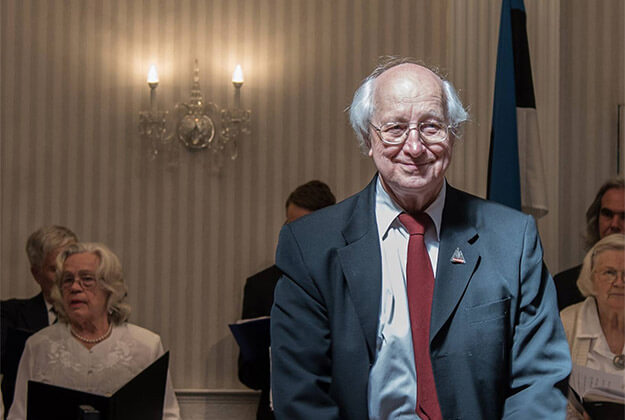 Conductor Andrejs Jansons. Photo by Ulla Vinkman
Conductor Andrejs Jansons. Photo by Ulla Vinkman
The Estonian Mixed Chorus’ Spring Concert took place on Saturday, May 2, at the New York Estonian House. After performing a program of songs both old and new and being entertained by the New York Estonian Folkdancers with an excellent program, the Choir president, Eha Brownell gave a speech enumerating some extraodinary achievments of maestro Andrejs Jansons’ career.
The choir dedicated the song “Ta lendab mesipuu poole” (“He Flies Towards the Bee Hive”) to him. A Letter from Maaja Roos, a well-known conductor herself, was read by Mall Kiil. Of course there was no shortage of well wishers with flowers and presents, starting with the Estonian Consulate General Eva-Maria Liimets and the New York Estonian Educational Society. After the program, everyone enjoyed the choir members’ wonderful refreshments of coffee, open sandwiches and a special cake from Kadri Kroon.
The speech by Eha Brownell, president of the Choir.
“Andrejs Jansons has played an important role in the furtherance of Estonian choral music in New York for the last 20 years. But sadly, this has been the final of our concerts that he will direct. He has decided to retire and will be moving to the Midwest sometime this summer.
You may know that Andrejs’ educational credentials include a Music Degree from the Julliard School as an oboist, and later a Masters in Choir Direction from the Manhattan School of Music.
Andrejs has an impressive list of achievements throughout his long career. For example, he has preformed as an oboist with a number of orchestras in the U.S., including the Baltimore Symphony and the Metropolitan Opera, as well as with chamber orchestras and other well-known opera companies. He was also music director of the NY Latvian Chorus and Orchestera.
In addition to all these professional accomplishments, Andrejs was willing to take on the responsibility of becoming choir director of the NY Estonian Women’s Chorus in 1995 and is now the director of the NY Estonian Mixed Chorus. During these 20 years, Andrejs has come to really appreciate Estonian choral music, especially pieces by Helen Duesberg and Urmas Sisask.
In 2002, Andrejs sought funding from the Estonian Bethany Church, and with his considerable hands-on involvement, Helen Tobias-Duesberg’s “Requiem” was published. He also arranged for the “Requiem” to be distributed to music directors, choruses and music libraries here and abroad. Helen Duesberg was in the audience at the live performance of “Requiem” in Riga. A CD of “Requiem” was also produced by the Latvian Chorus and Orchestra.
In addition, Andrejs conducted Sisask’s “Christmas Oratorio” as performed by the Latvian Chorus and Orchestra which was also recorded on a CD.
In 2012, Andrejs Jansons was honored by the Foundation of Estonian Arts & Letters in America for his contributions and support of Estonian culture – the first non-Estonian to receive this prestigious award.
Over the years Andrejs has made a conscientious effort to teach the Naiskoor – and now the Segakoor – to be better singers and to respect the music we perform. Always a perfectionist… but always supportive.
We love you, Andrejs, and we’ll miss you very much. But you have left us with such warm memories… of the strenuous warm-ups and vocal exercises you made us do… your rain-or-shine bicycle rides from New Jersey… your gentle teasing of some of the sopranos… We thank you from all our hearts, and we will miss you!”
A Letter from Maaja Roos honoring his 20-year tenure as conductor/maestro of the New York Estonian Women’s Chorus, was read by Mall Kiil.
“It has been wonderful to see from afar just how much Andrejs Jansons has promoted Estonian music and promoted the choral singing in the national identity of Estonians and for Estonians in the New York community. Of particular note is Andrejs’ recognition of the musical contributions of Helen Tobias-Duesberg, a self-effacing composer who was never in the habit of promoting her own music. Andrejs saw a wonderful opportunity to discover and perform many of her works, and in particular, her “Missa Brevis” and “Requiem”. That he was able to galvanize both the Estonian and Latvian communities to perform and record the “Requiem” was truly a feat. Together with the help of the Kiil family and their church, two magnificent editions went into publication and have been distributed to the larger musical world, and received with great interest. At present, Dr. Andre Thomas is interested in exploring the work to perform with the Tallahassee Symphony.
I will never forget the inspired expression on my mother’s face when she was present for the live performance in Riga during a Laulupidu. She was amused to be Helen Duesbergas and felt great affection for the Latvian musicians she met. Her gratitude to Andrejs Jansons to make “live music” out of her compositions was felt on a deep level. It inspired her to write more and to reach audiences on a spiritual level, since text on a written page can only become truly alive when it is played and sung. As one audience member said of a performance of the “Requiem” in Savannah, Georgia: “I feel as if I had completed my wordly life and arrived in Heaven”.
I think my mother would have been very happy to thank you at this juncture of your life, Andrejs. She would have said: “thank you for taking this music, cherishing it, and in turn, reaching singers and audiences in countless places. You have done a magnificent job as a musician”.
Aime Andra













